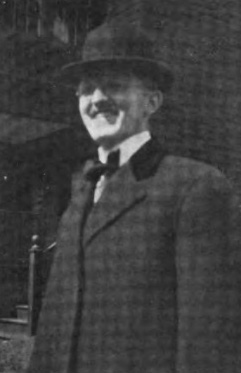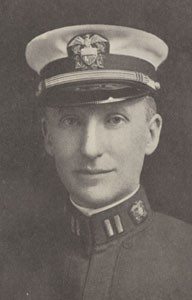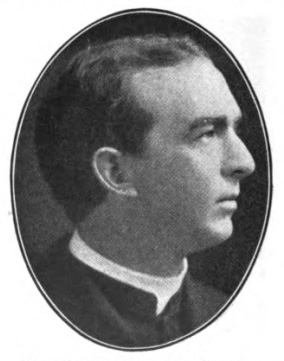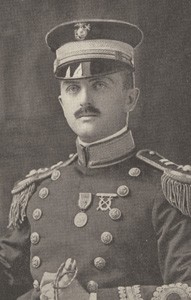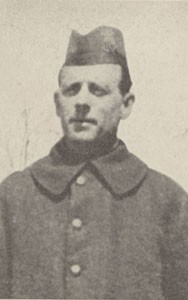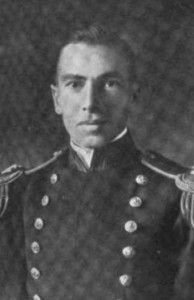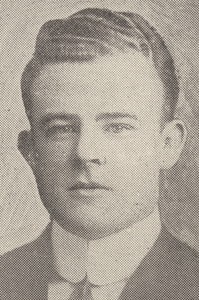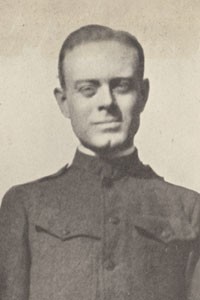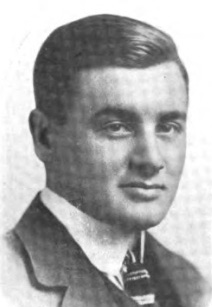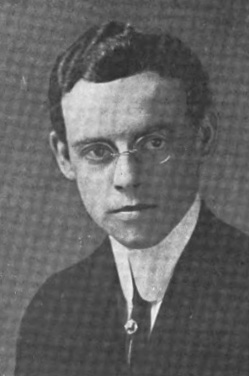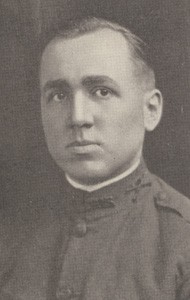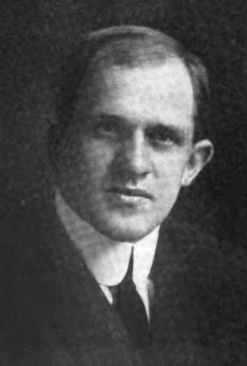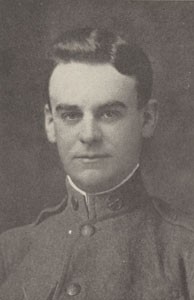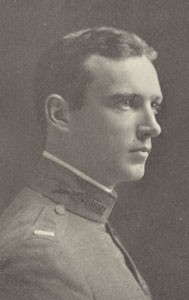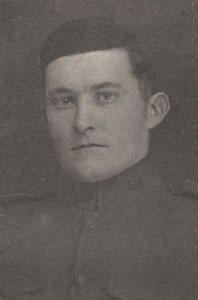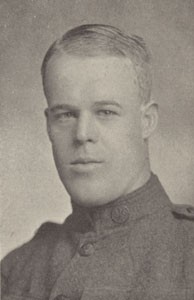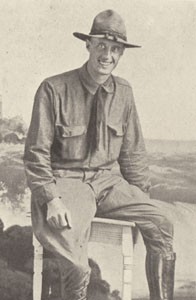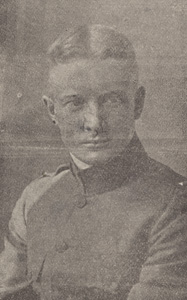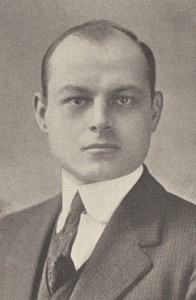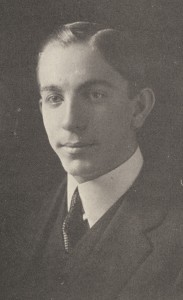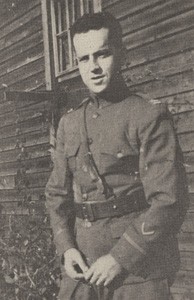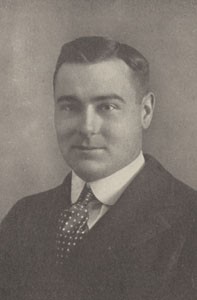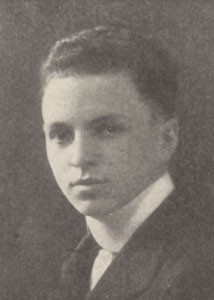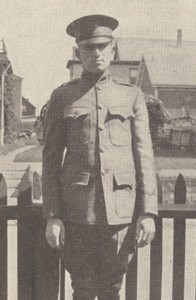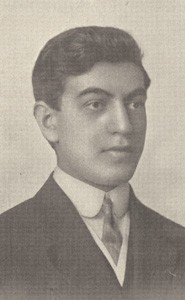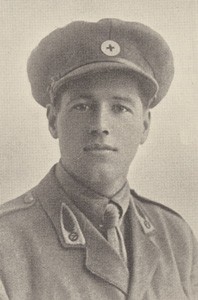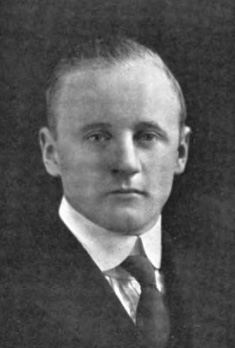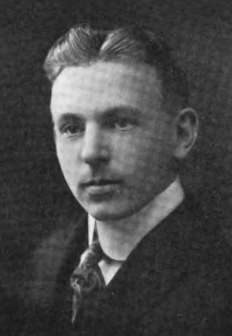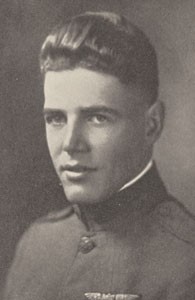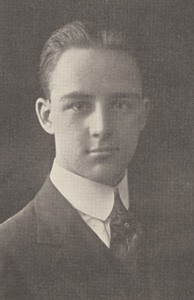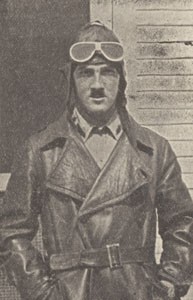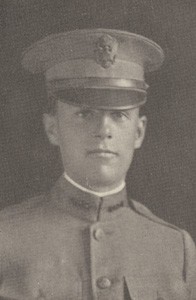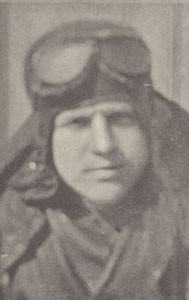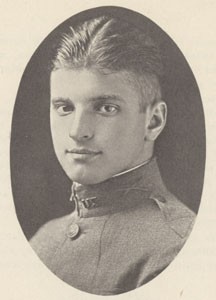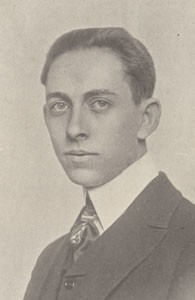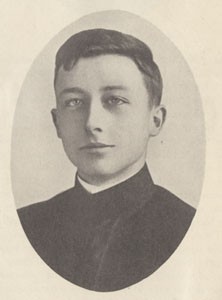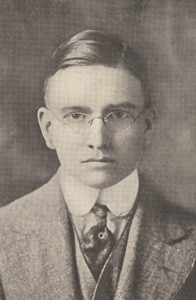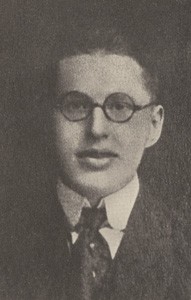During and after the war, the executive secretary of Brown’s War Work Committee spent months corresponding with next of kin, verifying information and requesting photographs, in order to compile biographies of the 42 men whose names are inscribed on the Soldiers Memorial Gate. In May of 1919, “Brown in the Great War” was published. The biographical excerpts below are taken from the publication’s Honor Roll, and from documents located in biographical files and necrology reports held in Brown University’s Archives. Lengthier biographies of the men can be read on-line in Hathi Trust’s digital copy of Brown in the Great War.
Henri Ferdinand Micoleau, Reserve Officer of French Infantry, Lieutenant, and Assistant Professor of Romance Languages and Literature at Brown University, was killed in action in the first battle of the Marne on September 9th, 1914. Micoleau had been at the front for just two days. He is the one faculty member that lost his life in the war. Lieutenant Micoleau fell near Virty-le-Francois is buried in nearby in a pine grove on a farm called La Certine.
Dr. William Henry Buffum, 1891, Lieutenant, Senior Grade, Medical Service, U. S. N., died of influenza in the Great Western Army and Navy Hospital in Liverpool, England, on October 13th, 1918. After an influenza epidemic broke out on his crowded transport en route to France. Dr. Buffam cared for the troops, and upon arrival in Liverpool on October 8th, he showed signs of the disease himself. He died less than a week later.
Rev. Thomas Aloysius Coffey, a non-graduate of the class of 1900, 1st Lieutenant Chaplin, United States Army, died of pneumonia at St. Joseph’s Hospital in Providence on January, 5th, 1918. Father Coffey was taken ill with influenza shortly after receiving his honorable discharge on December 15th, 1918.
William Everett Parker, a non-graduate of the class of 1901, Major in the U. S. Marine Corps, died on March 22nd, 1918, at the Naval Hospital in Washington D.C. Before joining the Marine Corp, Parker was a mechanical draftsman and designer for Brown & Sharp Manufacturing Company. After strenuous duties in Haiti, Parker fell ill while awaiting his commission in Washington and was hospitalized. Major Parker is buried at Arlington Cemetery.
Frederick Reynolds Belding, a non-graduate of the class of 1906, Corporal in Company K, 107th Infantry, was killed in action, near La Catelet, France, in the battle that broke the Hindenburg Line, on September 29th, 1918. Corporal Belding is buried in the Somme American Cemetery in Bony, France.
Florence John Harrington Price, class of 1906, Lieutenant, 42nd Overseas Battalion, Canadian Expeditionary Force, was mortally wounded by shrapnel at 3 p.m. on May 30th, 1916. Price had been sleeping in a dugout close to the front line near Ypres after taking the place of a fellow officer who was feeling ill. At Brown, Price was a prolific athlete and President of his class. Lieutenant Price is buried in Menin Road (South) Military Cemetery in Belgium. Price is the first Brown graduate to have died in the war.
Harold Stacey Burdick, U. S. N., Lieutenant-Commander, a non- graduate of the class of 1918, died of pneumonia at the Naval Station at New Orleans on January 16th, 1919. Burdick was a Hope High graduate. At Brown he was member of the Beta Theta Pi Fraternity. Lieutenant Burdick is buried at the United States Naval Academy Cemetery in Annapolis, Maryland.
Robert Emmett McGough, a non-graduate of the class of 1910, Private in Company L, 13th Regiment, U. S. Marines, died of pneumonia on September 25th, 1918, after being stricken with influenza while en-route to France. He was one of hundred men who died of the disease aboard the transport. Private McGough was part of a crack regiment of sharpshooters called “The Black Cats.”
Chester Thomas Calder, 1911, Private U.S.A Ambulance Service, died of pneumonia in Allentown, Pennsylvania on February 4th, 1918. Calder was a Providence Journal reporter, and well known in the city’s amateur theatricals. At Brown, Calder was a member of Theta Delta Chi. He enlisted in the Brown Ambulance Unit in the spring of 1917, and in June, went to Allentown for training. He died in the training camp’s hospital. Private Calder was buried with military honors in Providence, Rhode Island.
George Cormier Richardson, a non-graduate of the class of 1911, Machinist’s Mate, Naval Aviation, died of pneumonia on October 7th, 1918, at the Great Lakes Naval Training Station, Great Lakes, Illinois. At Brown, Richardson was manager of the Freshman Football team and a member of the Pi Kappa and Delta Phi fraternities. Richardson is buried in Rosehill Cemetery, Chicago.
Frederick Eames Cooper, 1913, Captain of Ordnance and officer in charge of production at the Watertown Arsenal, died of influenza-pneumonia on September 24th, 1918, at Watertown, Mass. Captain Cooper is buried at Swan Point Cemetery in Providence, Rhode Island.
Richard Dodson Robinson, 1913, 1st Lieutenant, Company K, 47th Infantry, American Expeditionary Force, died of wounds in Base Hospital No. 17, at Dijon, France, on August 31st, 1918. Robinson’s right leg was severely wounded by a shell on August 7th after his company got caught in a German bombardment. At Brown, Robinson was manager of the “Brunonian” and assistant manager of the track team. Robinson wrote several letters to his parents after his injury; in the last one, dated August 13, 1918, he reported that the doctor informed him that he would not lose the limb. The next correspondence his parents received was a telegram dated September 12th, announcing his death. Lieutenant Robinson is buried in the Dijon Cemetery, Dijon, France.
Raymond Booth Scranton, a non graduate of the class of 1913, private with Company B. 39th Engineers, died of lobar pneumonia on November 8th, 1918, at Camp Hospital #28 in Nevers, France. At Brown, Scranton was a member of the Delta Phi Fraternity. Private Scranton is buried in Grave 15, Cemetery 395, Nevers, France.
Clifford John Stevens, 1913, Corporal in Company F, 168th Infantry, died on March 15th, 1918, from an accidental grenade explosion in France. The captain of his company explained the events surrounding Corporal Stevens’ death to his father, writing “our outfit had been under the most grueling conditions for the previous seventy-two hours, and it was a most horrible climax and one that not a man that hurried along that dark road will ever forget.”[1. BUA. BAM, 19:112] Corporal Stevens is buried in Peronne, France.
Irving Thayer Boardman, 1914, Private, 9th Company, 3rd Battalion, 152nd Depot Brigade, Camp Upton, New York, died of influenza on September 27th, 1918. At Brown, Boardman was a member of Sigma Phi Epsilon. He was a graduate student at Clark University when he was drafted into service. Private Boardman is buried in Glenwood Cemetery, East Greenwich, Rhode Island.
David John Henry, 1914, 1st Lieutenant of the 301st Infantry, died of pneumonia at St. Nazaire, France, on February 14th, 1919. At Brown, Henry was a member of the Delta Upsilon Fraternity, played varsity football and basketball, and was captain of the football team his senior year. Lieutenant Henry is buried at Motor Reception Park in France.
Russell Lowell Bateman, a non-graduate of the class of 1915, private in the 10th, South Dakota Regiment, died of pneumonia in France on June 28th, 1918. Private Bateman is buried in Suresnes, near Paris.
Joseph Brown Bowen, 1915, 2nd Lieutenant Aviation Service, U. S. A., was killed in action on September 7th, 1918 while engaged on the Allied side of the lines in combat with a Fokker scout. Bowen had volunteered for the special patrol. Bowen signed up for service in aviation in 1917, after earning a Master of Forestry degree from Yale. Lieutenant Bowen is buried where his English comrades laid him, near the little village of Pronville, France, west of the Bourbon Wood and Cambrai. Above his grave, his squadron placed a cross, inscribed to his memory, made from the broken propeller of this plane. Read excerpts from some of Bowen’s letters.
Wilmur Hughes Eicke, 1915, private in Battery C, 103rd Field Artillery, 26th Division, was killed in action on October 24th, 1918. Eicke’s battery went into action in February of 1918. At Brown, Eicke was particularly active in modern language societies and dramatics. After abandoning his plans for a Ph.D, Eicke enlisted at Quonset Camp in the summer of 1917.
Rowland Hazard McLaughlin, 1915, Captain in the 314th Field Artillery, and former Executive Secretary of the University died of wounds received in action on October 14th, 1918 near the Meuse. McLaughlin was placed in charge after the battalion’s Major and adjutant were gassed. The battalion was ordered to be brought forward during daylight, although forward agents reported it impossible. He was last seen riding forward on horseback with a detail to make a personal reconnaissance. Captain McLaughlin was hit in the stomach by shell fragment, taken to dressing station near Fleury, and died within 24 hours. At Brown, McLaughlin was a student of high rank, a member of the Alpha Delta Phi fraternity, captain of the debating team, a member of the football and track teams, and captain of the swimming team. His senior year, he was president of his class and a member of the Cammarian Club. Captain McLaughlin left behind a wife and young daughter.
Frederick William Addison Miller, 1915, Private, Company M, 313th Infantry, died of pneumonia in France on September 23rd, 1918. Miller was within two months of receiving his Ph.D. when he was drafted into the Army in May of 1918. Miller’s regiment went into the trenches on September 13th. He survived five days of hard fighting in the Argonne, uninjured but ill. He was treated for two days by the field surgeon, and then sent on to a hospital, where died of lobar pneumonia two days later. Private Miller is buried near the hospital in Souilly, Meuse, France.
Howard Lewis Quimby, 1915, a private in Battery A, 304th Field Artillery, 77th Division, American Expeditionary Forces, died in the Le Man’s sector, France on March 11th, 1918. Quimby survived many campaigns without being wounded, but fell ill while his battery was awaiting orders to return to America. Private Quimby is buried at Woodlawn Cemetery in Acton, Massachusetts.
William Morris Sistare, Jr., a non-graduate of the class of 1915, Captain of the 17th Field Artillery, died of influenza at New London, Connecticut, on November 29th, 1918. In France, Captain Sistare had spent six months at the front lines under almost continuous fire. At Brown, Sistare was a member of the Chi Phi Fraternity and president of his senior class.
George Burton Cumberford, a non-graduate of the class of 1916, private in Machine Gun Company of the 101st Infantry, 26th Division, was killed in action on July 15th, 1918 near Chateau Thierry, France. During a severe bombardment, Cumberford was struck by shell and died shortly thereafter. At Brown, Cumberford was a member of the Lambda Chi Alpha fraternity. Prior to his induction into service on Jan. 21st, 1918, he served on the Providence police force, assigned to the Federal Hill section. Private Cumberford was buried by his comrades on the field of battle.
Earl Russell Fretz, 1916, 1st Lieutenant of the 12th Machine Gun Battalion, 4th Division, American Expeditionary Force died of pneumonia in Hospital No. 115, Vichy, France on November 7th, 1918. Lieutenant Fretz had been hospitalized in October after being severely injured by a machine gun bullet during the St. Michel drive of the Meuse-Argonne offensive. A fellow officer wrote that “his initiative, courage, and bravery was an inspiration to men under his command” and “after being injured he insisted on seeing that his men were properly taken care before being removed to the hospital.”
Jacob Rosenberg, 1916, 2nd Lieutenant at Camp Devens, Massachussets, died of lobar pneumonia at the camp on September 21st, 1918. Rosenburg had been sent to Camp Devens as an instructor, and had hardly arrived when he was taken ill with pneumonia, from which he died a week later. Lieutenant Rosenburg was buried with full military honors in Fall River, Massachusetts.
Abraham William Sidkowsky, a non-graduate of the class of 1916, private in Evacuation Hospital No. 5, Dunkirk, died of meningitis on December 19th, 1918. It was the pride of the hospital that it had never lost a patient; Sidkowsky was the only exception. He served at an evacuation hospital at Chateau Theirry, and then had assignments at Chateau Theirry, Villiers, Caterett, Ville-sur-Cousances near Verdun, La Veuve, and Staden, Belgium. Private Sidowsky’s burial ceremony took place in Rosendale, a small village east of Dunkirk, with a platoon of his company standing at attention.
Frank Elmer Starrett, class of 1916, Eleve Pilote, Ecole d’Aviation, Tours, was instantly killed near Pontlevoy, France, on the afternoon of January 3rd, 1918. Starrett had left the school for his first cross-country flight when “suddenly, the plane started to fall to the earth sideways as though hit by a heavy gust of wind under one wing, and then, turning, hit the earth nose down.” Starrett was one of four Brown men who were members of the elite Lafayette Escadrille, and was the second student from Brown to lose his life in the war. Starrett is buried in the military section of the cemetery at Tours, France.
Egbert Foster Tetley, class of 1916, former English instructor at Brown University, Lieutenant in Co. C., 47th Infantry, was killed in action, during an attack on machine gun nests at Bayoches, France on August 10th, 1918. After Lieutenant Tetley was wounded he lay and smoked a cigarette while waiting for the stretcher bearers. As he was being lifted upon the stretcher, he was hit again, all along the side by machine gun bullets. When asked by one of the men near him what they should do, he told them to “Stick to the last” and died shortly thereafter.
Joel Mead Austin, class of 1917, a private, first class in Company E, 418th Telegraph Battalion, died of pneumonia at Brest, France on September 30th, 1918. Private Austin arrived at Brest on September 25th, suffering from an attack of influenza contracted en route. Bronchial pneumonia developed, and he passed away five days later. At Brown, Austin was a member of Delta Tau Delta.
Paul Cartwright, a non-graduate of the class of 1917, 2nd Lieutenant in the American Aviation service, died of pneumonia at Base Hospital No. 1, Brest, France, on October 8th, 1918, shortly after arriving in France. At Brown, Cartwright was a member of the Beta Theta Pi fraternity. After graduation, he had been employed in the Engineering Department of the B & M railroad.
John Greene Rice, a non-graduate of the class of 1917, a member of Battery B, 101st Field Artillery, 26th Division, was killed in action, north of Verdun, on November 1st, 1918. Rice’s battery was in constant action from the first, and he was at the front continuously until his death. Rice was hit by a shell that hit him directly and killed him instantly. Rice was a graduate of Pawtucket High School. At Brown, he specialized in Chemistry. Rice is buried at Hammott, north of Verdun, three kilometers east of the Meuse River.
Carlton Merrill Bliss, a non-graduate of the class of 1918, a Lieutenant in American Aviation, died in an accident at Ford Junction Aerdome No. 1, at Sussex, England. on November 14th, 1918. Bliss graduated from Attleboro High School, and was later employed at the Attleboro Manufacturing Company. At Brown, Bliss was a member of the Phi Kappa Psi fraternity. He entered the Plattsburg Training Camp in April of 1917. Lieutenant Bliss was buried with military honors at the Morn Hill Cemetery in Winchester, England.
George Wheaton Carr Vaughan, a non-graduate of the class of 1918, 1st Lieutenant in Company E, 168th Infantry, 42nd Division, died of wounds in Base Hospital No. 68, at Mars, near Nevers, France on the day of the Armistice, November 11th, 1918. Vaughan had been seriously wounded at the Argonne on October 12th, after being almost continuously in action since July. Vaughan was a graduate of Hope High School. At Brown, he was the assistant manager of the track team, a member of the Musician and Cammerian Clubs, and member of the Pi Kappa and Psi Upsilon fraternities. Vaughan attended the Plattsburg Training camp in 1916, and returned in 1917. Lieutenant Vaughan was buried with full military honors in the officers’ cemetery at Mars-Sur-Allier, France. Read excerpts from Vaughan’s letters.
James Joseph Gray, former member of the class of 1919 and Naval Aviation Cadet was killed instantly, along with an officer and another student, in a plane crash in Pensacola, Florida on January 18th, 1919. Cadet Gray was in a H. S. 1 bombing plane at an altitude of about 1500, when the machine went into a tail spin, from which it never recovered. After the Armistice, Cadet Gray had felt obligated to finish his course. He had just passed his examinations and was awaiting his commission as Ensign in the Naval Reserve Flying Corps. when the accident happened. Cadet Gray was buried with military honors in Pittsburgh, Pennsylvania.
George West Berriman, a non-graduate of the class of 1920, 2nd Lieutenant, 167th Infantry, 42nd Rainbow Division, was instantly killed by a shell explosion in the trenches near Suipper on the Champagne front on July 15th, 1918. After attending the first Plattsburg Camp, Lieutenant Berriman went overseas with his division on September 12th, 1917. His death occurred while his platoon was defending their position against an artillery bombardment and attack of German Infantry and tanks. Read transcriptions.
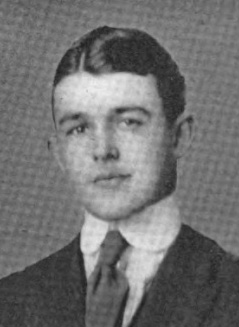
Edward Clifton Burnham, Jr., 1920, 2nd Lieutenant, Infantry, U.S.A. was killed by accident at the Machine Gun Range at Camp Johnson, in Augusta, Georgia on December 13th, 1918. Burnham’s father had been a member of the Brown Faculty in the Engineering Department from 1892 to 1902. At Brown, Burnham, along with his two brothers, were members of the Delta Upsilon fraternity. Burnham spent the summer of 1917 engaged in farm work for the purpose of increasing the national food supply.
John Stanley Hardman, 1920, First Medical Assistant, U. S. N. R. F., died of Influenza, on September 21st, 1918, at Newport, Rhode Island. At Brown, Hardman was a member of the Delta Tau Delta Society and of the Christian Science Church. During the summer of 1917, Hardman was employed in farm work for the purpose of increasing the food supply in Westerly, Rhode Island.
James Hemphill, non 1920, a private in Battery C, 103rd Field Artillery, 26th Division, was killed by accident in France during the March drive of 1918. Before entering Brown, Hemphill was president of this class at the Porter Military Academy in Charlestown, South Carolina. At Brown, Hemphill was a member of the Phi Kappa Psi fraternity.
George Gilchrist Luckey, a non-graduate of the class of 1920, and a private in the Medical Corps, died of influenza-pneumonia on February 11th, 1918, at Jefferson Barracks, Montana. Luckey had withdrawn from Brown to take up premedical work at the State University of Iowa. He was the first from that institution to die in the war.
Roland Herbert Sargent, a special student during 1917-1918 and member of the Field Artillery, U.S.A., fell ill and died in camp near Paris on December 2nd, 1918. In November of 1918, Sargent’s unit had sailed for France and was at sea during the signing of the armistice.
George Lyman Stratton, 1922, a member of the Brown Naval Training Unit, died of pneumonia at St. Joseph’s Hospital in Providence, Rhode Island, on December 6th, 1918. During his time at Brown, Stratton was fond of athletics, particularly basketball and baseball, and playing the violin.
Places mentioned in this story:
Virty-le-Francois, France; Liverpool, England; Providence, Rhode Island; Washington, D.C.; La Catelet, France; Bony, France; Ypres; Menin Road (South) Military Cemetery in Belgium; New Orleans, Louisiana; United States Naval Academy Cemetery in Annapolis, Maryland; Allentown, Pennsylvania; Great Lakes Naval Training Station, Great Lakes, Illinois; Rosehill Cemetery, Chicago; Watertown, Massachussets; Swan Point Cemetery in Providence, Rhode Island; Dijon, France; Nevers, France; Peronne, France; Camp Upton, New York; Glenwood Cemetery, East Greenwich, Rhode Island; St. Nazaire, France; Motor Reception Park in France; Suresnes, France; Pronville, France; Quonset, Rhode Island; Meuse, New London, Connecticut,France; Fleury, France; Souilly, Meuse, France; Le Man’s sector, France; Woodlawn Cemetery in Acton, Massachusetts; Chateau Thierry, France; Vichy, France; Meuse-Argonne, France; Camp Devens, Massachussets; Fall River, Massachusetts; Dunkirk, France; Villiers, France; Caterett, France; Ville-sur-Cousances, France; La Veuve, France; Staden, Belgium; Rosendale, France; Tours, France; Pontlevoy, France; Plattsburg, New York; Brest, France; Verdun, France; Hammott, France; Pawtucket, Rhode Island; Sussex, England; Attleboro, Massachusetts; Winchester, England; Mars, France; Argonne, France; Mars-Sur-Allier, France; Pensacola, Florida; Pittsburgh, Pennsylvania; Suipper, France; Augusta, Georgia; Newport, Rhode Island; Westerly, Rhode Island; Charlestown, South Carolina; Jefferson Barracks, Montana; State University of Iowa; Paris, France.

